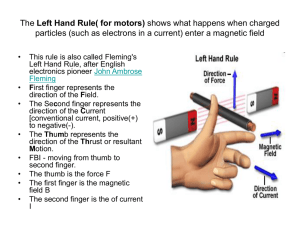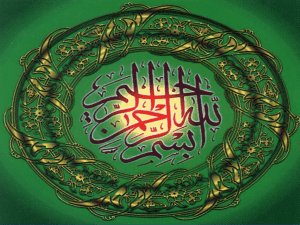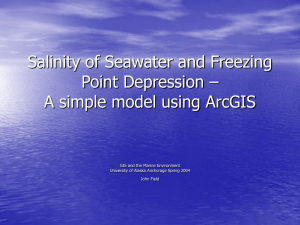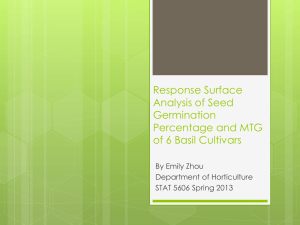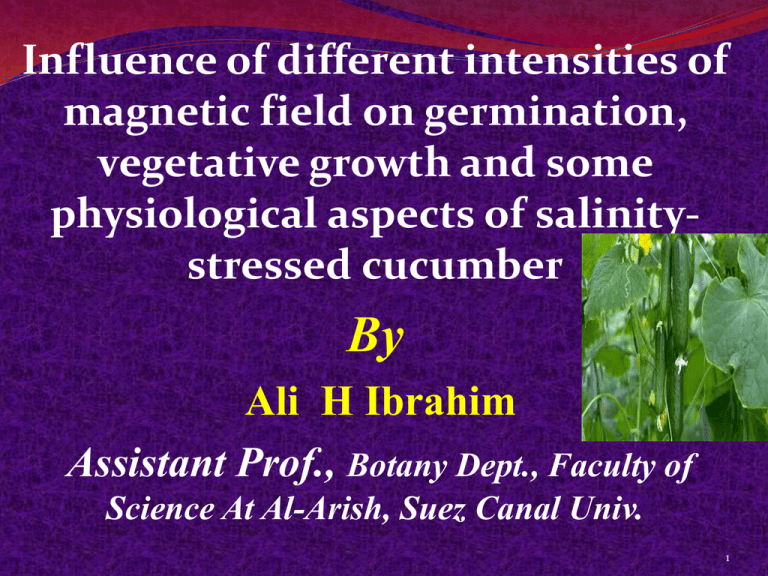
Influence of different intensities of
magnetic field on germination,
vegetative growth and some
physiological aspects of salinitystressed cucumber
By
Ali H Ibrahim
Assistant Prof., Botany Dept., Faculty of
Science At Al-Arish, Suez Canal Univ.
1
Outline Of The Presentation
The presentation will include:
1-INTRODUCTION
2-MATERIALS & METHODS
3-MAIN RESULTS & INTERPRETATION
4-CONCLUSION
2
1- INTRODUCTION
3
INT.
Salinity is one of the major environmental
factors
limiting
worldwide
productivity
and
distribution of crops in agriculture (PARIDA and DAS,
2005). One way to overcome the problem of salinity is
by exogenous application of advanced chemicals such
as plant growth regulators. The negative impact of
these chemicals on the environment has led the
agricultural scientists to explore the influence of
physical factors such as magnetic fields on plants
(TANVIR et al., 2012; BILALIS et al., 2013).
The literature survey reveals that most studies
have been concerned with the interactive effect of
magnetic field and salinity stress on plants during the
4
germination stage (CAKMAK et al., 2010; THOMAS et al.,
2013). Little researches have been carried out to explore
this dual effect at vegetative growth and late growth
stages.
Cucumber was selected for this study due to its
sensitivity to salinity, whereas its growth can be reduced by an
irrigation water with an EC higher than 1.2 dS/m
(CHARTZOULAKIS, 1992). Furthermore, no information is
available about the effect of seed magnetization on cucumber
vegetative growth.
Objectives of the study:
To investigate the influence of different intensities of magnetic
field on seed germination, vegetative growth, membranes
stability and some biochemical aspects of cucumber grown in
salinity stress conditions.
5
2- MATERIALS
& METHODS
6
Seeds material
Seeds of cucumber (Cucumis sativus L. var.
Beit Alpha) were used.
Magnetic field treatments
Seeds sterilization.
Seeds soaking.
Seeds packing in a cylinder of filter paper .
Seeds exposure to different magnetic fields
using the dia, para and ferromagnetism
apparatus (0.0 mT, 50 mT, 100 mT and 200 mT, at
30 seconds and 1/2 hour exposure time).
7
Fig.1. Dia, para and ferromagnetism apparatus
8
Germination experiment (for 5 days)
Experimental treatments (14 treatments)
Salinity
level
10 %
10 %
10 %
10 %
0
0
0
0
seawater
seawater
seawater
seawater
Magnetic
intensity
)mT)
0
50
100
200
0
50
100
200
Exposure
period
0
30 s, ½ h
30 s, ½ h
30 s, ½ h
0
30 s, ½ h
30 s, ½ h
30 s, ½ h
9
Measured parameters
1-Germination percentage.
2-Seedlings biomass and vigour.
Vigour index = Germination % × Seedling length
3-Assay of amylase
Starch–Iodine method with UV-Vis spectrophometer.
4- Peroxidase activity.
Spectrophotometerically by guaiacol oxidation
method
5- Total RNA
RNA in the samples was purified by silica-gel column
(SGC)-based isolation technology at FARP and
measured by UV spectrophotometer.
10
Follow up Measured parameters in germination
stage :
6- Total protein
Digestion, distillation and titration for total N
determination at FARP.
7- Metallic ions
Na and K by flame photometer . Fe by atomic
absorption spectrophotometer
8-Total soluble sugars
Spectrophotometrically by the anthrone method.
11
Vegetative growth experiment
Growth conditions
Pot experiment for 5 weeks where the plants
subjected to day night natural condition. Half of
pots were irrigated with 10% seawater.
Measured parameters
1-Shoot biomass.
2- photosynthetic pigments.
3- Membranes electrolytes leakage.
Based on measurement of electrical conductivity
of leaves ( initial EC initial, first EC and total
EC).
Statistical analysis
SPSS version 15 software.
12
3-RESULTS &
Discussion
13
14
15
16
17
18
19
20
21
200 mT
1/2h
200 mT
30s
100 mT 100 mT
1/2h
30s
50 mT
1/2h
50 mT
30s
0.0 mT
Controls
200 mT
½h
200 mT
30 s
100 mT
½h
100 mT
30s
50 mT
1/2h
50 mT
30s
0.0 mT
Salinity stress
22
23
4- CONCLUSION
24
Conclusion
1-The effect of magnetic field on cucumber depends on
magnetic intensity and exposure period.
2- The optimum doses to mitigate the adverse effect of
salinity stress on the used variety in germination and
vegetative stages is 50 mT for 1/2 h and 100 mT for 30 sec.
3- The enhancement effect of 50 mT for 30 seconds
appeared in the vegetative stage only.
4- The promotive effect of these magnetic treatments was
attributed mainly to the enhancement in total RNA,
soluble sugars, amylase activity and total chlorophylls, and
reduction in the electrolyte leakage.
5- High magnetic doses e.g. 200 mT for 1/2 h had a negative
impact on cucumber.
25
26







